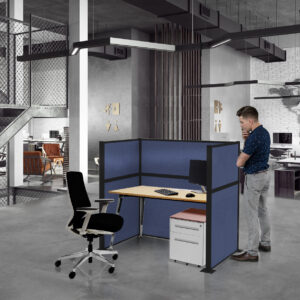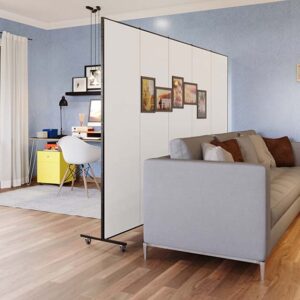Set Up a Successful Workstation with Ergonomic Office Furniture and Design
Market: Office
 Many people spend a significant amount of time working in a fast-paced, hustle-and-bustle office setting, whether it’s a traditional 40-hour work week in a corporate office or a remote setup at home. The sedentary nature of many jobs backs what your aching back is already telling you — sitting for extended periods of time can lead to a variety of health problems, from musculoskeletal disorders (MSDs) to heart disease, diabetes, and cancer.
Many people spend a significant amount of time working in a fast-paced, hustle-and-bustle office setting, whether it’s a traditional 40-hour work week in a corporate office or a remote setup at home. The sedentary nature of many jobs backs what your aching back is already telling you — sitting for extended periods of time can lead to a variety of health problems, from musculoskeletal disorders (MSDs) to heart disease, diabetes, and cancer.
Luckily, with the right knowledge, ergonomic furniture, and design, you can easily create a workspace that improves comfort, morale, and productivity.
What Are Ergonomics?
While the term “ergonomics” has become a buzzword in workplace wellness, the U.S. Department of Labor simply defines it as “fitting a job to a person.” If you’ve gone home after a long day of work with a sore lower back, swollen legs, or eye strain, you’ve experienced poor ergonomics. There are many elements in a healthy, thriving workspace, so let’s break it down so you can get your office dialed in on comfortable productivity.
Examples of Ergonomic Office Furniture and Design
Use this handy checklist when evaluating your ergonomics. Taking these considerations into account can alleviate some overdue stress, safeguard your joints, and ensure some extra comfort while working.
- Chair: Choose an adjustable chair that provides adequate support for your spine. Fine-tune the chair’s height to ensure your feet rest flat on the floor (or use a footrest if they don’t). Keep your thighs and hips parallel to the floor when seated. For armrests, position them so they allow your arms to rest comfortably with your elbows close to your body and your shoulders relaxed.
- Desk: The best option is an adjustable standing desk. Standing desks offer a quick transition between standing and sitting via button controls. Adjustable desks help promote movement, blood flow, mood, and more to combat negative health impacts associated with spending too much time sitting down.
- Keyboard and mouse: Position your keyboard in front of you to ensure your wrists and forearms align. Place your mouse within easy reach on the same surface as your computer keyboard. Maintain straight wrists, keep your upper arms close to your body, and position your hands at or slightly below elbow level.
- Monitor: Place the monitor straight in front of you, right behind your keyboard, at an arm’s length away. The top of the screen should be at or slightly below eye level.
- Telephone: If you spend a lot of time on the phone, try to put the phone on speaker or use a headset. Try not to cradle the phone between your head and neck.
- Lighting: Ensure sufficient lighting, including natural daylight, to reduce glare and prevent eye strain.
- Temperature: Occupational Safety and Health Administration (OSHA) recommends a temperature control of 68 to 76 degrees Fahrenheit for maximum comfort.
- Noise: Background noise in the workplace can be disruptive and lead to increased stress. Consider noise-canceling headphones, white noise machines, or cubicles with sound-dampening panels to minimize external distractions.
The Importance of Ergonomic Office Furniture
Research has consistently found that comfortable, well-designed, ergonomic furniture enhances physical well-being and contributes to increased productivity and job satisfaction.
- Enhance posture and spinal health: Ergonomic chairs and desks aim to foster proper posture and spinal alignment. They offer support to the natural curvature of the spine, lessening strain on the back, neck, and shoulders.
- Optimize comfort and alleviate discomfort: Specifically crafted for prolonged work hours, ergonomic office furniture is geared toward maximizing comfort. Features like adjustable height, lumbar support, and cushioning work to alleviate discomfort and deter the onset of chronic pain. Individuals can concentrate on their work without being hindered by distractions or interruptions.
- Increase productivity and efficiency: By eliminating physical discomfort and fatigue, employees can sustain focus and concentration for extended periods and expedite task completion.
- Save money: Minimizing workplace injuries helps your company avoid preventable compensation costs.
- Retain employees: A comfortable workplace fosters a positive company culture, fostering loyalty and inspiring long-term commitment from employees.
- Boost company image: A thoughtfully designed workplace elevates a company’s image and showcases a dedication to employee well-being.

Creating a healthy and comfortable work environment is crucial, and one key aspect is the use of ergonomic furniture. Making these investments can yield numerous benefits, including lowering the risk of injuries and enhancing productivity. If you’re seeking ways to improve your work experience, make the switch to ergonomic office furniture and design choices. Your body will appreciate it.
Need help planning your office space? Reach out to 855-960-6020 or contact Screenflex’s sales consultants for a consultation and support.